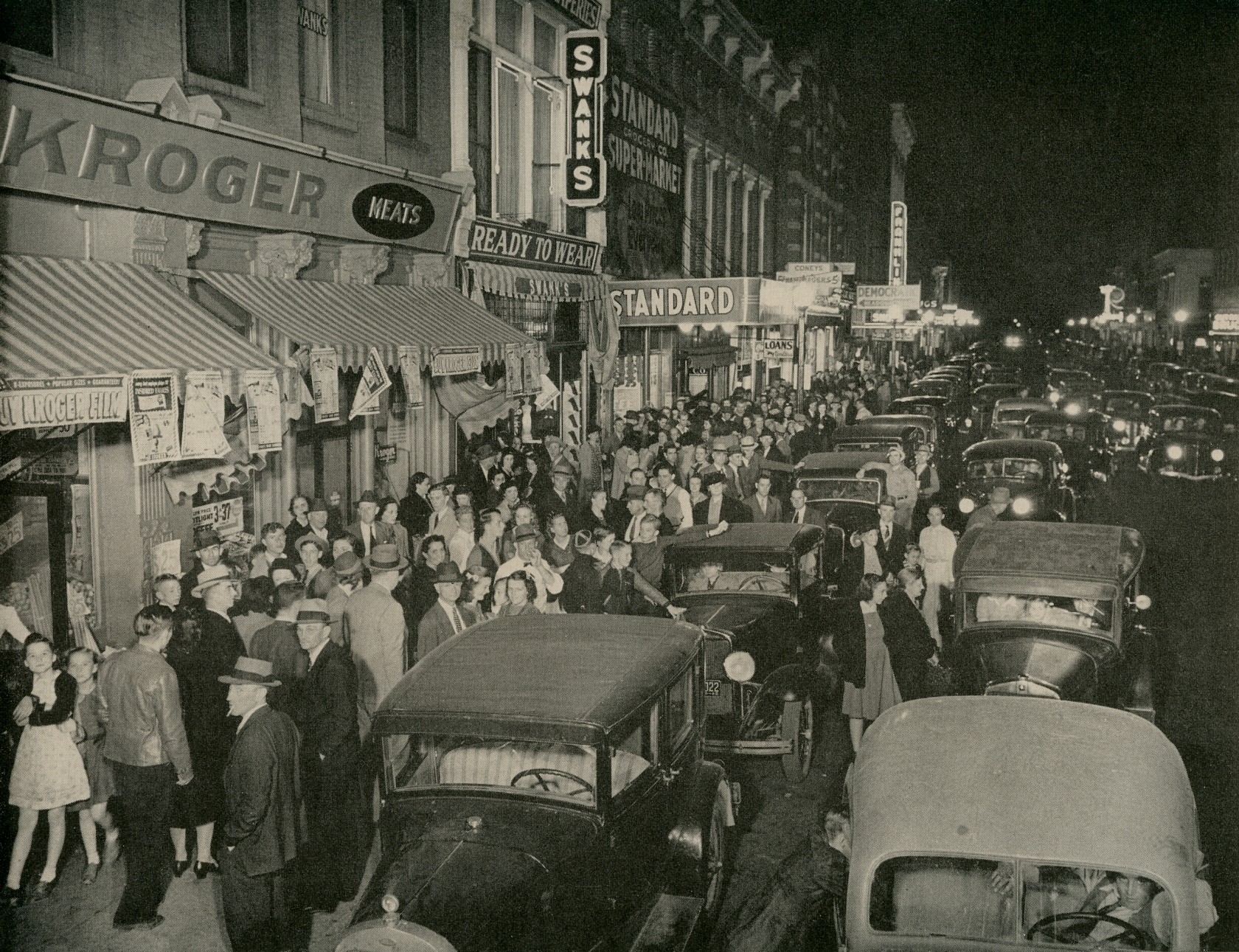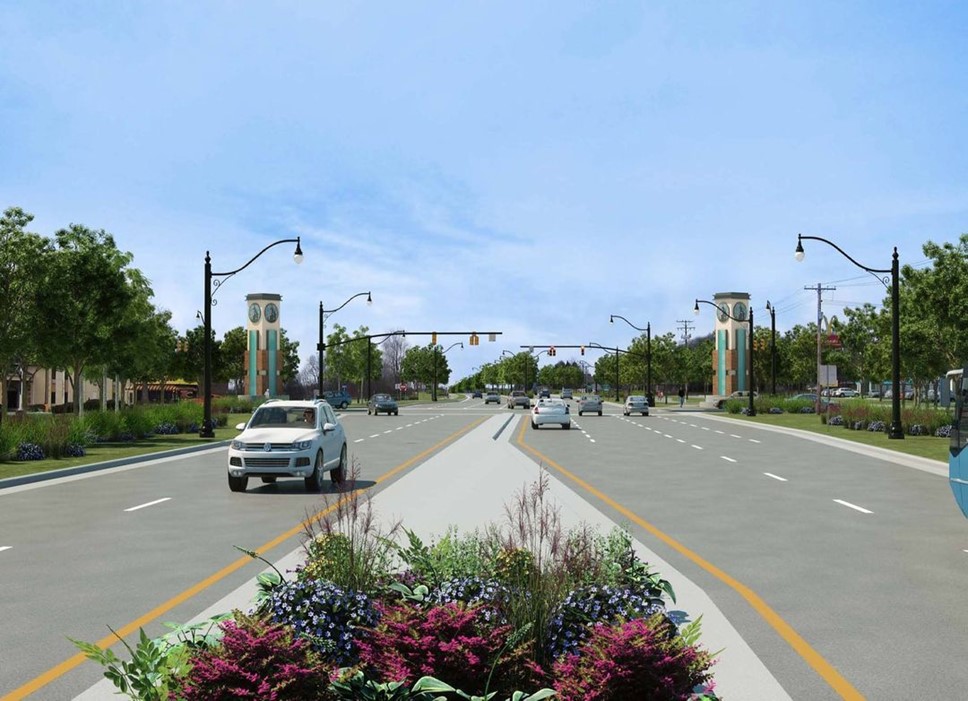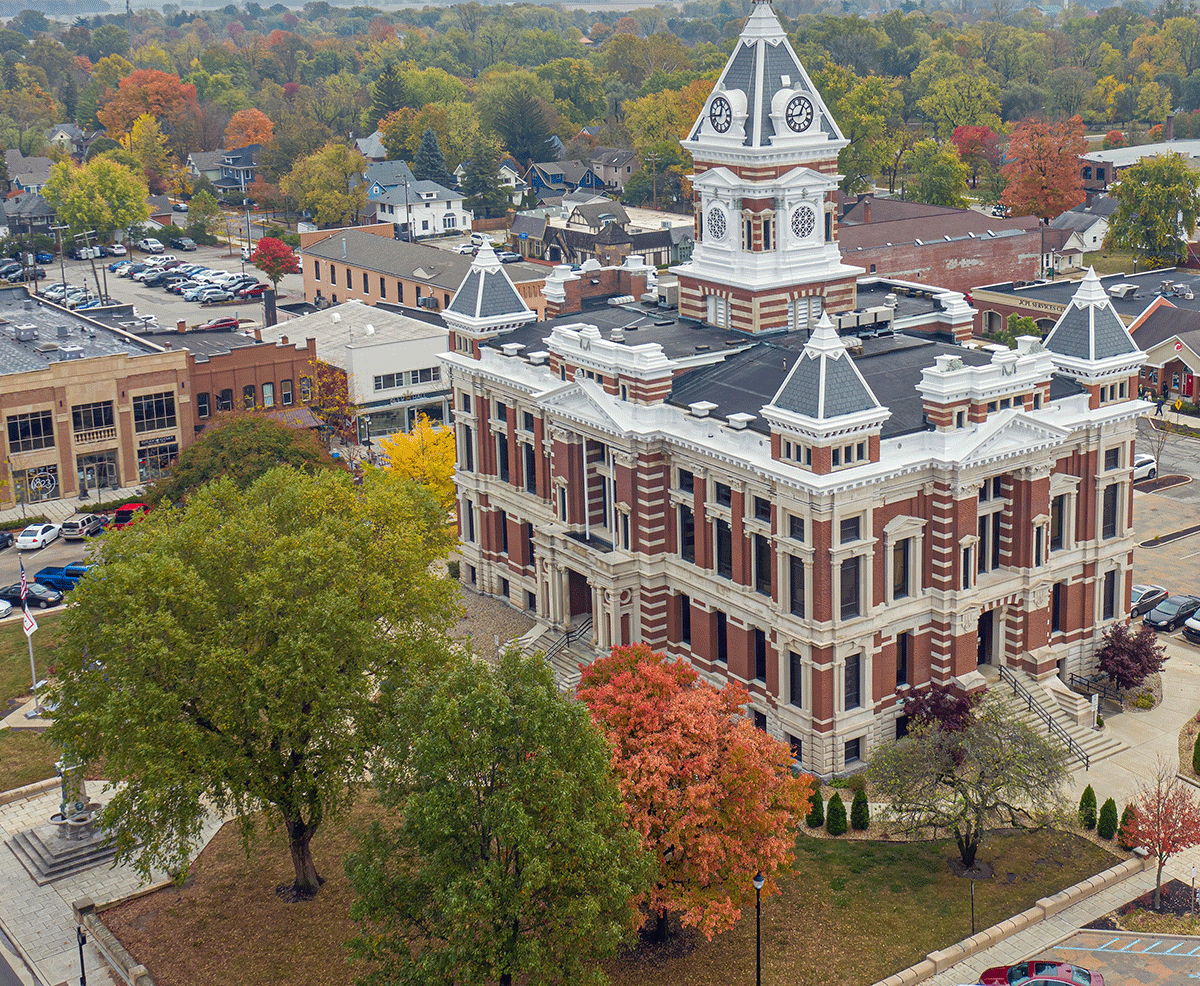
As Mayor of Franklin, Indiana, Joe McGuinness envisioned recreating the thriving city featured in a 1940 Life magazine story about Saturday night life in small-town America (photo, right).

The four miles between Interstate 65 and the city of Franklin have been called “the nicest gateway road in the state of Indiana.”
An established county seat, the city of Franklin is a historic small town with strong economic and social connections to the Indianapolis metropolitan region.
When Joe McGuinness served as Mayor of Franklin and Travis Underhill served as City Engineer, they helped implement improvements that transformed Franklin’s downtown and several gateways to the city — including “the nicest gateway road in the state,” according to urban policy consultant, researcher and writer Aaron Renn.
Franklin’s improvements include new roads, sidewalks and paths, old-style street lighting and new sewers. Joe and Travis — and their unique approach to communication, financing and project management — had a lot to do with the city’s success.
Downtown turnaround
When Travis and Joe became Franklin leaders in 2012, the city’s Gateways, Greenways and Redevelopment project was already underway. The result of a ‘City of Franklin, Indiana Gateways, Greenways and Redevelopment Study‘ prepared after a flood substantially altered downtown Franklin, the project addressed the four main entryways into the city of Franklin: from Interstate 65, North Main Street, South Main Street and Jefferson Street from the west.
“We were finishing the first phase when we arrived,” Travis said. It included the brick streets and parking areas surrounding Franklin’s famous Johnson County Courthouse, as well as the North Main Street construction project.
Both projects had reached a critical point in their development. “The area was in the midst of construction, and it looked like a bomb had gone off,” Travis said. “Business owners and homeowners were experiencing a lot of heartache.” When the situation reached a crisis point, Joe and Travis considered halting all of Franklin’s projects. But, at that critical moment, they found a way to turn things around.
They started by focusing on building relationships with local businesspeople and helping them understand the incremental nature of road and infrastructure construction. Travis gave business owners his email address and cell phone number, and he began to send targeted weekly emails to the people most affected by construction. “This is the worst it will ever be,” he told them. “Every day that clicks by from now on will be better. Today we have a piece of sidewalk. Tomorrow we’ll have a driveway. The next day we’ll have water service.”
“My emails were very detailed,” said Travis, who also engaged the community through in-person workshops and public meetings. “I said, ‘I’ll give you all the information I can, and I’ll seek more if needed, but I need you to join us.’”
This communication style was different from the carefully controlled public relations messages people were used to, but it worked. “Over time, we learned that, when people in the community know what’s happening, projects go smoothly,” Travis said. “Transparency creates accountability on both sides, and it makes people partners instead of adversaries.”
Travis and Joe’s focus on transparency built trust in the community — and kept projects on track. The City of Franklin embraced this new, more open, communication style, so much so that now it’s simply how things are done.
Making dreams real
A second study took a more detailed look at the King Street entry to Franklin. “The study showed what potential outcomes could be,” Travis said. “The idea was: If you build welcoming towers, realign the intersection and stretch unique lighting features all the way out to the interstate, you’ll attract new hotels and sit-down restaurants. That theory has proved out.”
Travis considers planning studies essential for several reasons. “Not only does a study paint a vision, it creates a tool for a community to source financing,” he said. “And it shows commitment and buy-in. When you’re seeking financing from federal, state or private partners, studies can sharpen your competitive edge.”
The Franklin’s City Council and Board of Public Works and Safety were so pleased with the plans, the city sought bonding to accelerate the city’s rehabilitation. Once financing, including $20 million in federal funding, was secured for Franklin, Joe and Travis brought projects to bid and oversaw construction of:
- New towers on both sides of the road to welcome visitors and residents
- New park-style landscaping throughout the area
- Grass medians with concrete curbing
- Trails on both sides of the roadway
- New welcome signage (for the City of Franklin as well as local nonprofits)
- New lighting features all along the corridor to I-69
Ultimately, all of the suggested improvements were completed, including a downtown hub and entrances to the city from the north, east and west. Joe and Travis also oversaw completion of the State Road 44 reclamation project. “Everything that we dreamed of actually got built,” Travis said.
The improvements helped pave the way for new developments, including two much-needed hotels (a Hilton Garden Inn and a Hampton Inn) and new restaurants. Along the corridors, older developments saw a renaissance, too. “As we were rebuilding the road, we watched families come in, buy historic homes and fix them up,” Travis said.
Other developments and investments in the area soon followed, including these improvements near Interstate 69:
- A new Hampton Inn and Suites
- A new Fairfield Inn and Suites
- Several new restaurants
- Investments in mixed-use and multifamily properties
Investments in Franklin’s downtown core led to these improvements:
- Investments in the Artcraft Theatre
- Arrival of B2S Life Sciences (tech and health care job creation)
- Façade improvements in the downtown core
- Newkirk Square being developed
- Garment Factory rehabilitation
- Historic home restorations
- Main Street multifamily upgrades
Today, Franklin frequently draws crowds who attend festivals and performances at the city’s new amphitheater and spend time in the city’s quaint downtown area. Joe and Travis may have reached their goal of helping make Franklin a thriving small town once again.
Timeline
2012
Joe McGuinness is elected mayor of Franklin, Indiana; Travis Underhill becomes Franklin’s City Engineer.
2013
Spring: Joe and Travis begin conversations with the Indiana Department of Transportation (INDOT) about State Road 44.
Fall: Franklin accepts $13 million in federal funding via INDOT and $80,000 from the State of Indiana to revitalize a nearly four-mile section of State Road 44 within Franklin’s city limits.
2014
- The city of Franklin takes over operational responsibility for the State Road 44 corridor and immediately repaves the worst sections of the road.
- Franklin is awarded the first installment of additional federal funding for Jefferson Street in the downtown core of the city ($2.1 million).
- Franklin is awarded federal funding for a second section of Jefferson and King streets ($1.2 million).
2015
- The city of Franklin reconstructs the first section of Jefferson Street (formerly State Road 44) just west of U.S. 31 using local funding, setting the tone for future phases.
- Interstate 65 Interchange Economic Development Plan is commissioned and completed, providing a planning document to complete gateway improvements at the city’s front door.
- A third installment of federal funding is received to extend a portion of King Street (former State Road 44) on the east end of the corridor adjacent to Interstate 65 ($1.8 million).
- Franklin receives a fourth installment to build a pedestrian trail along the newly dedicated Commerce Bypass ($1.4 million).
2016
- Franklin receives a fifth installment of federal funding for the corridor to complete pedestrian enhancements between the first reconstructed phase and the western roundabout ($1.7 million).
- Gateway construction is completed at the I-65 interchange, reinventing Franklin’s eastern entrance to the city.
- Corridor reconstruction begins with the first phase of Jefferson Street in the downtown core area, thus beginning a nine-phase project.
- Garment Factory Project kicks off with Wayne Street road funding granted by the INDOT Community Crossings Matching Grant Program.
- B2S Life Sciences partners with the city to renovate historic downtown buildings and create jobs in the tech and health care industries.
2017
Construction continues on the remaining eight phases of the corridor project as Joe McGuinness and Travis Underhill take on new roles at INDOT.
2019
Fairfield Inn and Suites opens at I-65 interchange.
2020
Hampton Inn and Suites opens at I-65 interchange.

$30 MILLION: Total funding secured for Franklin’s revitalization
$20+ MILLION: Public investments generated at Franklin’s I-65 interchange

$30+ MILLION: Improvements and investments in downtown Franklin

$75+ MILLION: Total economic development from Franklin’s gateway, downtown enhancements
As Mayor and City Engineer, Joe McGuinness and Travis Underhill used strong negotiation, communication and financing skills to help make Franklin, Indiana, a thriving small town once again. At Avenew, Joe and Travis put those skills to work to help others achieve similar goals. What could they do for you?






